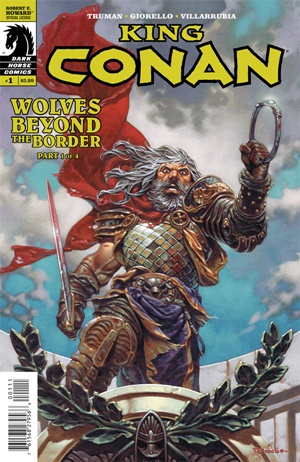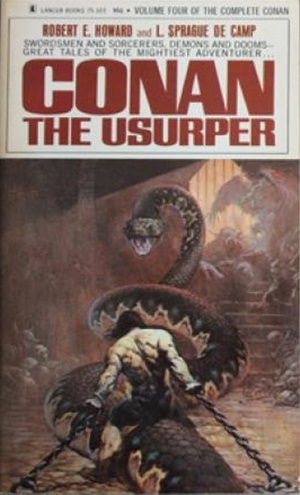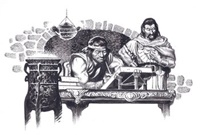Hither Came Conan: Woelf Dietrich on “Wolves Beyond the Border”
 And with only four stories remaining, Hither Came Conan is winding down. Of course, this series has featured a different leading Robert E. Howard expert each week, examining one of the original Conan stories each week, highlighting what’s best in it. Author Woelf Dietrich looks at the ‘most complete, incomplete’ Conan tale from Howards, “Wolves Beyond the Border.” Read on!
And with only four stories remaining, Hither Came Conan is winding down. Of course, this series has featured a different leading Robert E. Howard expert each week, examining one of the original Conan stories each week, highlighting what’s best in it. Author Woelf Dietrich looks at the ‘most complete, incomplete’ Conan tale from Howards, “Wolves Beyond the Border.” Read on!
I am to provide proof that “Wolves Beyond the Border” is the greatest Conan story ever told by Robert E. Howard. Except that Conan never appears in the story apart from a mention or two and Howard never completed the story nor was it published in his lifetime. L. Sprague de Camp finished the fragment relying on a one-page outline discovered with the unfinished manuscript that Howard had written in the 1930s. Lancer Books published it in 1967 along with three other stories in Conan the Usurper.
So, as you can see, I find myself in a peculiar situation. A potential dilemma given the awesome essays published so far in this series. The competition for the best Conan story is a fierce one. How, then, do I convince you that this story is the best despite the absence of Conan?
Let us start with the plot, shall we?
Plot
We are introduced to “Wolves Beyond the Border” with a mini-prologue:
“The revolution progresses with hurricane speed. While knights and sergeants in gleaming mail clash in charge and counter-charge on the Aquilonian plains, civil war rages along the Pictish frontier between the partisans of Conan and those of Numedides. The Picts, naturally, see their opportunity. Here is a tale of some of the events of that strife-torn land, as told by one of the survivors of the conflict; for the Hyborian Age was a time of stirring events in many times and places, not merely those in which Conan was present.’
The tale is set against the backdrop of revolution as Conan and his supporters battle King Numedides for the throne of Aquilonia. While chaos ensues and uncertainty and mistrust reign high, the Picts seize the opportunity to strike across the border and attack a weakened village and nearby fort.
The story is told from the point of view of Gault Hagar’s son, a border ranger from the Free Province of Thandara along the Thunder River. While on a secret mission to bring word from the Governor of Thandara that Thandara has declared for Conan and is ready to aid his friends and defy his enemies, Gault stumbles cross a secret Pictish ceremony conducted by Tenayoga, a Ligurean shaman. In attendance, strangely enough, is an Aquilonian who Gault later discover is a nobleman called Lord Valerian.
On impulse, Gault let loose an arrow into Tenayoga’s chest and flee with dozens of bloodthirsty Picts after him. His luck holds and he escapes to Fort Kwanyara, near the village of Schondara. At the village, Gault meets Hakon Strom’s son and his rangers in a tavern and delivers his message. Gault also discovers the identity of Lord Valerian as well as his treachery when Valerian arrives at the tavern. Here yet again we see the impulsive nature of Gault as he immediately jumps up and confronts Valerian without giving it a second thought.
Valerian is arrested but escapes later that night with the help of Kwarada, a half-Pict, half-Leguran known as the witch of Skandaga. Before Valerian disappears into the Pictish Wilderness, he sends a chakan to kill Gault. Gault manages to defeat the human-like beast by splitting his skull with a hatchet.
Together Gault and Hakon and six rangers follow Valerian’s trail to a nearby cabin on Lynx Creek where they see him and the witch meet with Tenayoga and his band of Gunderman guards. Other Pict tribes are also in attendance.
This is where Howard’s story stopped. What follows is de Camp’s narrative as guided by the summary Howard left with the manuscript.
They learn that the leaders of three Pictish tribes plan to join forces with the help of a wizard in Ghost Swamp who will convince a fourth tribe, the wolfmen, to join them. The Picts fear the wolfmen would plunder their settlements while they are away attacking Schondara.
Gault and Hakon and his rangers attack the cabin, setting it alight and slaughtering the Picts as they try to escape. However, Valerian and the witch manage to escape along with a few Picts. Gault and Hakon with two rangers follow them to Ghost Swamp while the remaining rangers return to town to warn the villagers and prepare for battle.
 Both Gault and Hakon are captured in the swamp and the remaining rangers killed. At the wizard’s encampment, both Gault and Hakon are tied to a stake each. The wizard gives the tribes a sack filled with demons and send them to attack Schondara with the order that when they release the demons the Picts must immediately fall to the ground and lay as flat as possible as the demons will only attack people standing upright. The wizard remains with the two captives and after throwing some bones falls into a trance.
Both Gault and Hakon are captured in the swamp and the remaining rangers killed. At the wizard’s encampment, both Gault and Hakon are tied to a stake each. The wizard gives the tribes a sack filled with demons and send them to attack Schondara with the order that when they release the demons the Picts must immediately fall to the ground and lay as flat as possible as the demons will only attack people standing upright. The wizard remains with the two captives and after throwing some bones falls into a trance.
Gault, who had flexed his torso and arms when the Picts had tied him, manages to free himself. After a quick search, he finds no weapon except for the wizard’s knife and a bow and quiver with arrows used to hunt fowls. Gault kills the wizard by strangling him and uses the knife to free Hakon. They both rush after the Picts and arrive just in time to see them attack the village. Gault draws the bow and shoots the sack containing the demons. A multitude of winged demons escape and immediately attack the shocked Picts who forget to drop to the ground. Gault and Hakon find the severed head of Valerian and we are told at the story’s close that Conan has taken the throne as the new king of Aquilonia.
Discussion
“Wolves Beyond the Border” is different in style and setting to Howard’s other Conan stories with the exception of “Beyond the Black River,” which showed a similar style and theme. I suppose it makes sense if you consider that “Wolves Beyond the Border” was written as a companion piece to “Beyond the Black River”. Keith West is correct here in saying that instead of the usual dark cities and Stygian deserts, these two stories feature a setting and atmosphere akin to the American Frontier. This was immediately noticeable. The rangers even wear moccasins and Picts are depicted with feathers in their hair and war paint on their bodies and faces. Together this just makes them come across as a fantasy version of American native Indians.
Personally, I do not agree with the choice in footwear as Howard describes the rangers wearing moccasins. The origin of moccasins refers to footwear used by First Nations peoples and include sandals, boots, and leggings and is unique to our reality. It felt alien and out of place in a Hyborian setting. I do understand the use of such soft-felt shoes, especially when one is hunting in wooded areas, but Howard could maybe have used another name or description. As such, the reference to moccasins only further grounded the frontier setting and atmosphere.
Although Conan never makes an appearance, he still looms large as we are told of the civil war in Aquilonia. The ongoing revolution is a constant theme and its presence is felt across the country and is alive in the story. Confusion and chaos reign as loyalties are divided between those who support Conan and those siding with King Numedides, ruler of Aquilonia. It makes the story appear far larger than it is and lays a foundation of possibilities for further adventure and action and tales of honour and bravery. The Picts with the help of the traitor Valerian tried to capitalise on the confusion and weakened defences of the frontier settlements but failed and we are informed at the story’s closing that Conan successfully took the throne.
According to de Camp, the half-written story was in final draft form and he used the summary found with the fragment to complete the story. Some people may have issue with the detailed explanations of the frontier landscape and various provinces along with excessive info dumping, but I got the distinct impression that Howard was busy, at the time of writing it, anyway, expanding Conan’s world and he used this story to do just that, to set up a world for future tales.
In answering the question of whether this story should qualify as the best Conan story, I had to imagine myself as someone who knows nothing about Howard and who has never read a Conan story before. “Wolves Beyond the Border” provides a compulsive but brave hero, lots of action, an expanded frontier world, and various Pict tribes and beasts. It also features supernatural forces, a staple of Conan stories. “Wolves Beyond the Border” paints Conan as this great warrior for whom people are willing to go to war for and die. It features the legend of Conan and although Conan makes no appearance, there is no mistake that this is his world. His bravery and tales of adventure are known and celebrated. What the story thus succeeds in doing is awaken a curiosity to find out more about Conan and his world, and that is a valuable thing.
Conclusion
I cannot in good conscience say this is the best Conan story Howard ever wrote because there are so many other stories that actually feature Conan and are superior in plot and action. However, “Wolves Beyond the Border,” tells a story that makes the reader curious and does so in an entertaining way. It celebrates the legend of Conan and because of this reason, I can say, without a doubt, that this is the best non-Conan Conan story ever told.
It is my understanding that the Lancer series of Conan stories propelled Conan to a greater readership and thanks should thus be given to De Camp who, with the help of Lin Carter, introduced Conan into popular culture. “Wolves Beyond the Border” was later adapted by Roy Thomas and Ernie Chan in Savage Sword of Conan 59 and then again in 2015 and 2016 by Timothy Truman and Tomas Giorello for Dark Horse Comics.
From the Dusty Scrolls (Editor comments)
Del Rey’s The Conquering Sword of Conan includes a ten page fragment of this story, followed by an eighteen page version. As Woelf mentioned, de Camp completed the story. I think he did a pretty good job, and the approach in this story makes it something more than just a Conan tale.
Patrice Louinet compares the approach of Conan being an off-stage supporting actor in his own story to a similar incomplete Kull tale.
Gault is a more than worthy hero for the story.
“Wolves Beyond the Border” was the fifth and final King Conan story from Dark Horse Comics, running from December, 2015 through March, 2016.
Prior posts in the series:
Here Comes Conan!
The Best Conan Story Written by REH Was…?
Bobby Derie on “The Phoenix in the Sword”
Fletcher Vredenburgh on “The Frost Giant’s Daughter”
Ruminations on “The Phoenix on the Sword”
Jason M Waltz on “The Tower of the Elephant”
John C. Hocking on “The Scarlet Citadel”
Morgan Holmes on “Iron Shadows in the Moon”
David C. Smith on “The Pool of the Black One”
Dave Hardy on “The Vale of Lost Women”
Bob Byrne on Dark Horse’s “Iron Shadows in the Moon”
Jason Durall on “Xuthal of the Dusk”
Scott Oden on “The Devil in Iron”
James McGlothlin on “The Servants of Bit-Yakin”
Keith West on “Beyond the Black River”
Fred Adams on “The Black Stranger”
Stephen H. Silver on “Man Eaters of Zamboula”
Keith J. Taylor on “Red Nails”
Ryan Harvey on “Hour of the Dragon”
The Animated Red Nails Movie that Never Happened
Mark Finn on “The God in the Bowl”
Bob Byrne on “Rogues in the House”
Bob Byrne on the the Khoraja Saga
Woelf Dietrich used to be a lawyer – now he’s an author living in New Zealand, where his works havew been nominated for awards several times. He writes primarily dark fantasy and speculative fiction (that lawyer thing probably came in handy…).
Bob Byrne’s ‘A (Black) Gat in the Hand’ was a regular Monday morning hardboiled pulp column from May through December, 2018.
His ‘The Public Life of Sherlock Holmes’ column ran every Monday morning at Black Gate from March, 2014 through March, 2017 (still making an occasional return appearance!).
He also organized Black Gate’s award-nominated ‘Discovering Robert E. Howard’ series.
He is a member of the Praed Street Irregulars, founded www.SolarPons.com (the only website dedicated to the ‘Sherlock Holmes of Praed Street’) and blogs about Holmes and other mystery matters at Almost Holmes.
He has contributed stories to The MX Book of New Sherlock Holmes Stories – Parts III, IV, V and VI.
And he is in a new anthology of new Solar Pons stories, out now.

“Best non-Conan Conan story,” eh? Works for me! I haven’t read this one for many years, likely since I last cracked the covers of my copy of Conan the Usurper. Thanks for refreshing my memory.
I must say I always thought the picture of Conan’s coming to power over Aquilonia as evoked in this story much grander than the direct version later penned by de Camp and Carter as Conan the Liberator. Here, it’s part of a movement. There it comes across as much more dicey, with Conan’s victory appearing chancy, almost accidental.
That said, I suspect de Camp found finishing up Gault’s adventure congenial, since the frontier setting it features is based on his own neck of the woods (literally). He was raised in Upstate New York in the vicinity of Thendara (Howard’s Thandara). It was a popular place, evidently, as Marion Zimmer Bradley also borrowed it as a locale for her Darkover series.
I always enjoyed this story because of the depth it helped to give REH’s Hyborian Age. It is a tale of courage set against a backdrop of war on a savage frontier and Howard told it well. It seemed to show that his world lived, breathed and fought even though Conan and his henchmen/enemies weren’t in the picture themselves.
“Best non-Conan Conan story”? I’ll go with that.
Great post, Woelf. I have to agree with you that this is the best non-Conan Conan story. The best Conan story being “Beyond the Black River”, of course. 🙂
I like that you looked at what de Camp and Carter did to finish the story, although as a general rule I’m not a big fan of the stories de Camp and Carter finished. I wish Howard had finished it and written more stories set in the Hyborian Age that didn’t feature Conan.
Still, as you point out, this is a good story and definitely worth reading.
Amusing opening, Woelf, I greatly enjoyed it. I think, perhaps, this would have been the most challenging story to defend for me. 🙂
I agree that it is most assuredly “the best non-Conan Conan story ever told.” I enjoyed the SSOC version quite a bit.